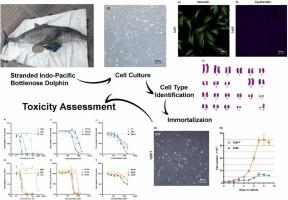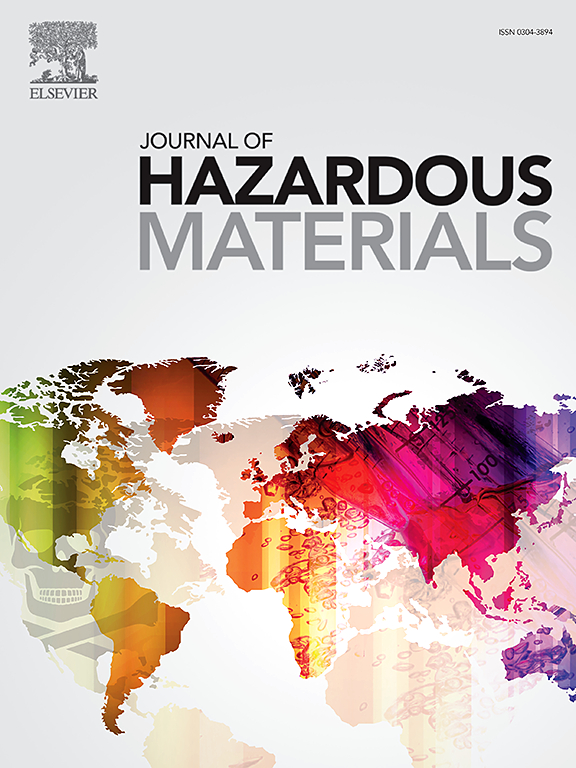Establishment of the First Dermal Fibroblast Cell Line derived from the Indo-Pacific Bottlenose Dolphin (Tursiops aduncus) and Its Response to Pollutant Exposure
IF 12.2
1区 环境科学与生态学
Q1 ENGINEERING, ENVIRONMENTAL
引用次数: 0
Abstract
The Indo-Pacific bottlenose dolphin (Tursiops aduncus), classified as a new species since 1998, is underexplored in ecotoxicology owing to ethical constraints and the lack of specific in vitro models. Herein, we established the first skin fibroblast cell line (TaSF) from an Indo-Pacific bottlenose dolphin stranded along the Pearl River Estuary, China. TaSF cells exhibited strong proliferation in early passages but ceased mitosis at passage 19, likely owing to reaching the Hayflick limit. Morphology and immunofluorescence tests confirmed the fibroblastic nature of these cells. Karyotyping revealed 21 pairs of autosomes and 1 pair of sex chromosomes (XY), consistent with many cetaceans. To facilitate long-term future studies, TaSF cells were immortalized with exogenous simian virus 40 T antigen, creating the TaSFT cell line. The cytotoxic effects of 27 contaminants, including 6 organotins (OTs), 10 per- and polyfluoroalkyl substances (PFASs), and 11 phthalates (PAEs), on TaSFT cells were evaluated after 24-h exposure. Among these chemicals, OTs exhibited the strongest cytotoxicity, and both OTs and PFASs showed structure-related toxicity. These findings confirm the feasibility of TaSFT cells as a novel tool for ecotoxicity research on the Indo-Pacific bottlenose dolphin and highlight the need for further investigation into the environmental contaminant pressures on this species.

建立首个源自印度-太平洋宽吻海豚(Tursiops aduncus)的真皮成纤维细胞系及其对污染物暴露的反应
印度洋-太平洋瓶鼻海豚(Tursiops aduncus)自 1998 年起被列为新物种,但由于伦理限制和缺乏特定的体外模型,该物种在生态毒理学方面的研究不足。在此,我们建立了第一个皮肤成纤维细胞系(TaSF),该细胞系来自中国珠江口搁浅的印度洋-太平洋瓶鼻海豚。TaSF 细胞在早期增殖旺盛,但在第 19 代时停止了有丝分裂,这可能是由于达到了 Hayflick 极限。形态学和免疫荧光测试证实了这些细胞的成纤维细胞性质。核型分析显示有 21 对常染色体和 1 对性染色体(XY),与许多鲸类一致。为了便于今后的长期研究,TaSF 细胞在外源性猿猴病毒 40 T 抗原的作用下永生,形成了 TaSFT 细胞系。暴露 24 小时后,评估了 27 种污染物对 TaSFT 细胞的细胞毒性影响,其中包括 6 种有机锡(OTs)、10 种全氟和多氟烷基物质(PFASs)以及 11 种邻苯二甲酸盐(PAEs)。在这些化学物质中,OTs 表现出最强的细胞毒性,OTs 和 PFASs 都表现出与结构相关的毒性。这些发现证实了将 TaSFT 细胞作为一种新型工具用于印度洋-太平洋瓶鼻海豚生态毒性研究的可行性,并强调了进一步研究环境污染物对该物种的压力的必要性。
本文章由计算机程序翻译,如有差异,请以英文原文为准。
求助全文
约1分钟内获得全文
求助全文
来源期刊

Journal of Hazardous Materials
工程技术-工程:环境
CiteScore
25.40
自引率
5.90%
发文量
3059
审稿时长
58 days
期刊介绍:
The Journal of Hazardous Materials serves as a global platform for promoting cutting-edge research in the field of Environmental Science and Engineering. Our publication features a wide range of articles, including full-length research papers, review articles, and perspectives, with the aim of enhancing our understanding of the dangers and risks associated with various materials concerning public health and the environment. It is important to note that the term "environmental contaminants" refers specifically to substances that pose hazardous effects through contamination, while excluding those that do not have such impacts on the environment or human health. Moreover, we emphasize the distinction between wastes and hazardous materials in order to provide further clarity on the scope of the journal. We have a keen interest in exploring specific compounds and microbial agents that have adverse effects on the environment.
 求助内容:
求助内容: 应助结果提醒方式:
应助结果提醒方式:


